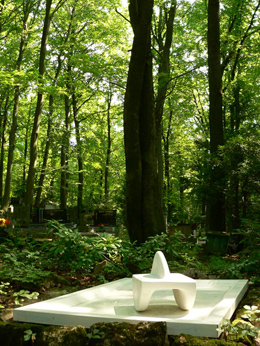
People do not invest as much in the artistic decoration of graves as they used to
 |
| Svatopluk Sládeček: Grave of the Jabůrkovy family, Zlín (2005) |
"In the last 20 years, very few interesting individually designed gravestones have been created. The taste of the people commissioning the gravestones has also deteriorated. Society no longer considers it as important as it did in the past," said geologist and funeral architecture expert Drahomíra Březinová to ČTK.
"Today, funeral architecture is not like in the First Republic; people today cannot afford it. Large tombs are no longer made. Ordinary, cheap things are made instead," noted Prague stonemason Josef Červenec.
Notable architects such as Jan Kotěra and Josef Gočár and sculptors like František Bílek and František Uprka created gravestones for Prague cemeteries at the beginning of the 20th century. For example, Olšany Cemetery features graves in Art Nouveau, Cubist, Neo-Gothic, and Functionalist styles. Among the most well-known contemporary artists who have designed gravestones is Jaroslav Róna, who paints in a studio at the Prague Jewish cemetery.
Currently, stonemasons offer both artificial and natural stones, such as granite, marble, sandstone, limestone, travertine, basalt, or slate. Natural stone is also more expensive due to its processing. A modern trend combines stone with cut glass.
The light granite is the most popular, partly due to its price, and the prices of monuments are formed according to customer wishes, says Červenec. It depends on the processing and the number of accessories. "There is no price list for this; each gravestone is specific," claims Červenec. Prices for urn monuments range between ten to 50,000 crowns, and for "single graves" from 30 to 80,000 crowns. Truly expensive tombs, which can cost several million crowns, are now rare. Public figures who value ostentatious presentation choose them.
Due to a lack of space and funds, so-called urn graves have emerged in recent years. This is especially common in Prague, where 96 percent of funerals are cremations, says Martin Červený, who is in charge of the Prague Cemetery Administration, which oversees cemeteries in Ďáblice, Vinohrady, Bubeneč, Olšany, and Malvazinky. However, according to him, these graves disrupt the original character of historical cemeteries due to their unconventional shape. The indifference of people towards the graves of their loved ones is also evidenced by the fact that 30 percent of graves remain unpaid. However, this does not apply to the graves of Romani people, who maintain them daily as part of their traditions.
The English translation is powered by AI tool. Switch to Czech to view the original text source.
0 comments
add comment











